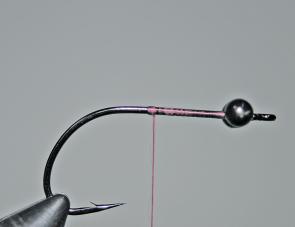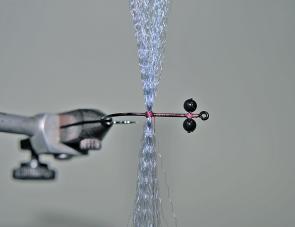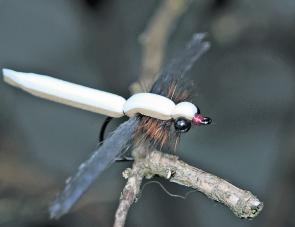There are many different fly patterns to represent a broad array of terrestrial and aquatic inhabitants. Many species of fish are opportunistic feeders that will rely on insects to form a decent part of their diet. This month’s pattern, the Foam Dragonfly is a good imitation of a common dragonfly that can be found around most freshwater environments.
Dragonflies can easily become dinner for trout, bass and saratoga so it pays to have a few of these at your disposal, especially when other patterns are being refused and the fish are being a little pedantic in their feeding.
There are numerous species of dragonflies in various parts of the country. They come in numerous sizes and colours from small vivid blue models to large, almost black ones. However, one thing they all have in common is that they possess nearly identical silhouettes when seen from below. For this reason the Foam Dragonfly is a generic dragonfly pattern that is likely to work in most waters.
If you want to get specific then you can change the colour or profile to suit your requirements.
The foam I have used for the body is actually two different coloured foams joined together. These can be purchased already like this or you can adhere two together yourself.
The brown side is tied in so it can be seen from below, the darker colour providing a prominent silhouette against the backdrop of sky. The white portion is facing up to allow the angler good visibility of the fly, allowing them to maintain a position on it in fast flowing water or dull conditions, such as the evening hue. Wings can be made from numerous materials however I like how the streamer hair looks and the fact that it dries fast and does not remain waterlogged during casting.
Fishing dragonfly patterns is not that dissimilar to fishing with many trout style dry flies. The fly is not cast out and retrieved, or dragged through the water like many of the other patterns used to target bass and saratoga. The Foam Dragonfly is simply allowed to rest on the water surface after being presented.
Obviously a high floating line and monofilament leader is used for this presentation. An occasional short strip or twitch on the line can help the fly get noticed by cruising fish. The wings and tail have a degree of movement and will make the pattern appear alive and struggling when the line is twitched.
Every few minutes the fly can be lifted back off the water and re-represented. Slapping the fly down on the surface, by twitching the line just before the fly lands, can be a good ploy to get the attention of predating fish. Often the strikes will be sudden and you will need to strike quickly before the assailant realises its mistake and spits the fly.
(1) Place the hook securely in the vice and attach the thread with a jamb knot just behind the hook eye. Lay down a bed of thread for around 5mm and attach the mono eyes with a figure-of-eight wrap about 3-4mm behind the hook eye. Continue the thread along the hook until it is approximately two-thirds the way along the shank.
(2) Cut a portion of streamer hair that is approximately 9-10cm long. Tie these strands in the middle across the hook shank, where the thread ends, with a series of figure-of-eight wraps. Add a little vinyl cement to the thread securing the eyes and the wings (image taken from above).
(3) A few millimetres behind the wings, approximately opposite the hook point, secure the strip of foam to the back of the hook shank with the white side facing upwards. Leave just enough foam facing forward so the tip surpasses the hook eye.
(4) Advance the thread forward to just in front of the wings. Tie in the butt of the hackle then advance the thread forward, stopping about 3-4mm short of the mono eye.
(5) Palmer (wrap) the hackle forward with each wrap just in front of the last. Tie off at the point where you stopped your thread. Next tie down the foam strip at this same point and advance the thread forward to just behind the mono eyes.
(6) Palmer the hackle forward again right up to the mono eyes, tie off, whip finish and remove the remaining hackle. Fold the foam strip over the mono eyes and trim level with the rear of the hook eye. Tie this down securely with a series of wraps then whip finish and add a little vinyl cement. Trim the tail so it is roughly as long as the entire hook. Fold the two wing upwards and hold them together and trim so they are even and about 3cm long.
(7) Your Foam Dragonfly looks very realistic. Check out the profile from below, which is how any predating fish will see it. Enjoy fishing this awesome little pattern when you next hit the freshwater.
MATERIALS
| HOOK: | Gamakatsu B10S #2 |
|---|---|
| THREAD: | Flat-waxed nylon, fiery brown |
| EYE: | Mono, large black |
| WING: | Streamer hair, smoke |
| BODY: | Tiewell evasote strips, bicolour frog |
| LEGS: | Grizzly saddle hackle, brown |
| FINISH: | Vinyl cement |











